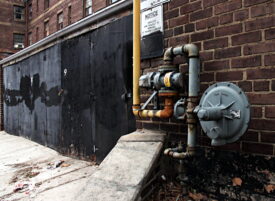Washington Policy Center, a right-leaning think tank, is shopping around a legislative memo opposing an increase in the state’s hazardous substance tax. The memo is riddled with errors, including two big ones.
First, WPC claims on page 1:
The state would collect new revenues by increasing the tax rate on hazardous substances imported into Washington. This would increase gas prices by four to six cents per gallon.
That’s false. And it’s obviously false to anyone who bothers to perform some simple arithmetic. All you need to do is multiply the tax increase (1.3%) by the wholesale price of gasoline (about $2.30)…
So in other words, the correct answer is that the impact would be less than 3 cents per gallon. (It could be even less if the full price is not passed on to consumers, as it may not be.) If you want to see the full math for yourself, please read my post, “Correcting the Oil Industry’s Errors.”
Alternatively, if you don’t believe me, you could just check with the oil industry directly. Even they agree now that the price increase is, at most, 3 cents. Not surprisingly, that’s also what the state’s Department of Revenue says: 3 cents, at most.
Second, WPC claims on page 3
…the claim that stormwater delivered 52 million pounds of pollutants to the Puget Sound was in error. In fact, the corrected numbers show that only about 14 million pounds, or 6,500 tons, of pollutants per year enter the Sound via stormwater…
That’s false too. And, once again, it’s obviously false to anyone who does a little bit of research. In fact, what the numbers show that the volume of pollutants is likely somewhere between 14 million pounds and 94 million pounds. In other words, 52 million pounds, which WPC thinks is an error, is actually a pretty comfortable mid-point estimate for pollution. So either they are cherry-picking a low-end estimate (and misleading readers about it), or else they’ve just got their facts wrong.
What’s truly bizarre about this error is that WPC actually includes a table from a Department of Ecology report to prove their point. (By the way, they neglect to label the table or provide units of measurement.) But here’s the thing: it’s the wrong table!
WPC uses the table to make a claim about the total volume of pollution when in fact the table shows only the volume of pollution that is categorized specifically as “oil and grease,” a subcategory. It gets weirder though, because the very table that WPC includes in their report shows that “oil and grease,” all by itself, accounts for as much as 92 million pounds of pollution in Puget Sound per year. WPC apparently didn’t bother to convert from metric tons into pounds! If they had, they’d clearly see the range of Ecology’s estimates for oil pollution that enters Puget Sound: somewhere between 12 and 92 million pounds per year.
Admittedly, that’s a wide range and a lot of uncertainty — which I discussed last month in a post called “How Much Petroleum Enters Puget Sound in Stormwater.” Regardless, it’s either sloppy or dishonest for WPC to misrepresent the low end of a wide range as Ecology’s official figure. And if you don’t believe me about the numbers, and you don’t want to wade through technical tables, just read the the Department of Ecology’s recent easy-to-understand summary:
Ecology currently estimates that Puget Sound receives between 14 and 94 million pounds of toxic pollutants annually, which include oil and grease, PCBs, phthalates (a plasticizer), PBDEs (flame retardants), as well as toxic heavy metals such as copper, lead, and zinc.
Let’s hope no one takes the WPC memo too seriously.
There is a legitimate debate about whether to increase taxes on hazardous substances in Washington. But, at minimum, everyone should try to operate in good faith and agree on the basic facts of the case.
Update 12:58: For a post not riddled with errors, check out this from the Washington Budget and Policy Center









Jon Stahl
Gotta love those conservatives: when the facts aren’t on their side, they just make stuff up. Nice fisking, Eric!